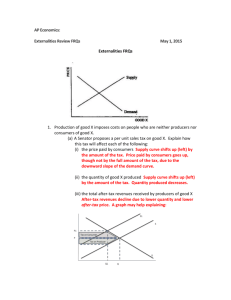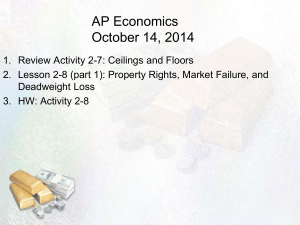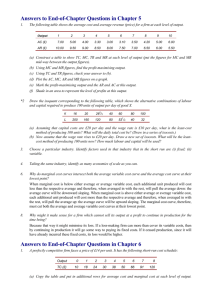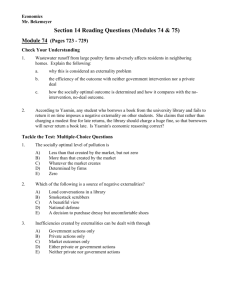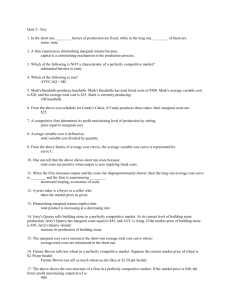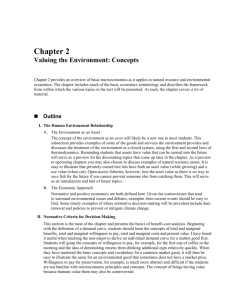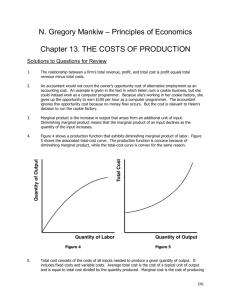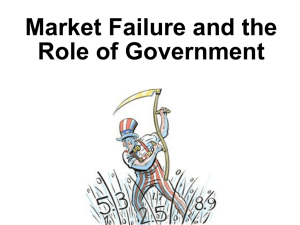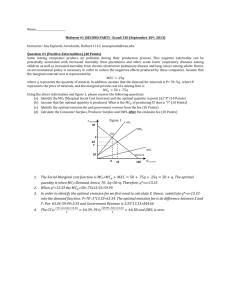Econ 325: Environmental and Natural Resource Economics
advertisement
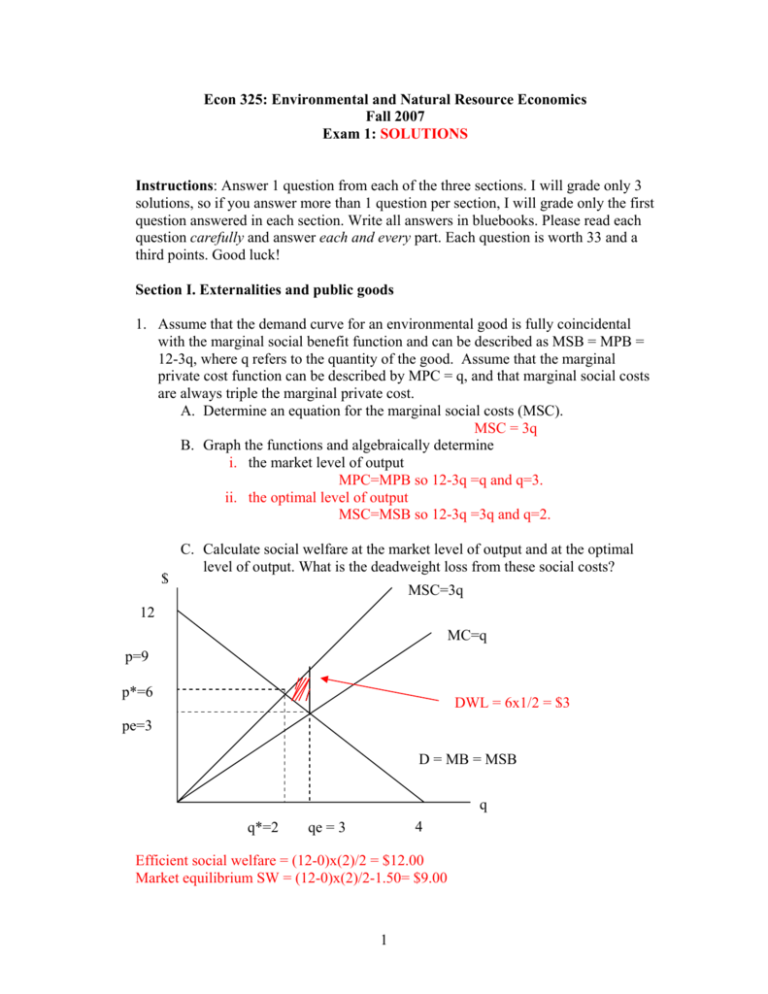
Econ 325: Environmental and Natural Resource Economics Fall 2007 Exam 1: SOLUTIONS Instructions: Answer 1 question from each of the three sections. I will grade only 3 solutions, so if you answer more than 1 question per section, I will grade only the first question answered in each section. Write all answers in bluebooks. Please read each question carefully and answer each and every part. Each question is worth 33 and a third points. Good luck! Section I. Externalities and public goods 1. Assume that the demand curve for an environmental good is fully coincidental with the marginal social benefit function and can be described as MSB = MPB = 12-3q, where q refers to the quantity of the good. Assume that the marginal private cost function can be described by MPC = q, and that marginal social costs are always triple the marginal private cost. A. Determine an equation for the marginal social costs (MSC). MSC = 3q B. Graph the functions and algebraically determine i. the market level of output MPC=MPB so 12-3q =q and q=3. ii. the optimal level of output MSC=MSB so 12-3q =3q and q=2. $ C. Calculate social welfare at the market level of output and at the optimal level of output. What is the deadweight loss from these social costs? MSC=3q 12 MC=q p=9 p*=6 DWL = 6x1/2 = $3 pe=3 D = MB = MSB q q*=2 4 qe = 3 Efficient social welfare = (12-0)x(2)/2 = $12.00 Market equilibrium SW = (12-0)x(2)/2-1.50= $9.00 1 D. Is it possible to correct this externality? Explain. Yes, through taxes (Pigou) or bargaining (Coase). Explain where to tax (at optimal output level.) Answers will vary. 2 2. Suppose the state is trying to decide how many miles of a very scenic river it should preserve. There are 100 people in the community, each of whom has an identical demand function given by P=10-1.0q, where q is the number of miles preserved and P is the per mile price he or she is willing to pay for q miles of preserved river. Hint: treat this river as a public good. A. If the marginal cost of preservation is $500 per mile, how many miles would be preserved in an efficient allocation? This is a public good, so add the 100 demand curves vertically. This yields: P = 1,000-100q. This demand curve would intersect the MC curve when P = 500, which occurs at q = 5 B. What are the net benefits associated with the preservation project? 1,000 500 MC = 500 D q 5 ½ * ($1,000-$500) * 5 = $1250. 3 Section II. Environmental valuation and decision making 3. Assume that the data you have suggest that if: i. Travel cost is greater than or equal to $30, no trips are taken ii. If travel costs are zero, 100 trips are taken. A. Draw a travel cost demand curve based on these data. B. Calculate ordinary consumer surplus for the individual whose travel costs are equal to $14. C. Explain potential biases your analysis may have included. The information provides the end points of a straight line. P = 30 – (30/100)*Q After find equation for straight line, plug in $14 for price and solve for quantity. 14 = 30 – (30/100)*Q => Q = 53.3 trips Calculate consumer surplus, which is area below demand curve and above price at $14. $ 30 CS = ½ * (30-14) * 53.3 = $426.67 14 Trips 53.3 100 May not be accounting for true opportunity cost of time, may be incorrectly including travel costs for multiple stops on trip, and may include sample bias from frequent visitors. 4 4. Assume that the costs and benefits associated with a proposed government project are as follows: Year Benefits Cost ($ millions) 0 1 2 3 200 500 1500 800 500 500 500 200 A. If the discount rate is 5 percent, calculate the present value of the net benefits for this project (show your work). (200 − 500) (500 − 500) (1500 − 500) (800 − 200) + + + = $1125.33 0 1 2 3 (1 + 0.05) (1 + 0.05) (1 + 0.05) (1 + 0.05) B. Not all of the benefits associated with this project are easily quantifiable in dollar terms. What can be done to account for these factors? It is important to note these benefits and discuss their potential importance, do sensitivity analysis, discuss how results depend on assumptions. 5 Section III. Sustainability 5. The notion of sustainability is not the same in the natural sciences as in economics. In the natural sciences, sustainability frequently means maintaining a constant physical flow of each and every resource (e.g., fish from the sea or wood from the forest), while in economics it means maintaining the value of those service flows. When might these two choices lead to different choices? Why? Weak vs. strong vs. environmental sustainability, what each entails and examples of why they would lead to different decisions. (Answers will vary) 6 6. Assume society is trying to allocate 40 units of a depletable resource across two time periods. Demand is given by the equation P = 16 – 0.5Q. The marginal extraction cost for the resource is constant at $1 per unit. The discount rate is 0.10. A. What are the efficient quantities for each of the two periods? MNB1 MNB2 15 13.636 0 40 10 30 Q1*=20.475 Q2*=19.524 30 10 40 0 B. What are the efficient prices for each of the two periods? P1*=$5.763 P2*=$6.238 C. What is the marginal user cost associated with this resource in each period? MUC1=$4.76 MUC2=$5.23 7


